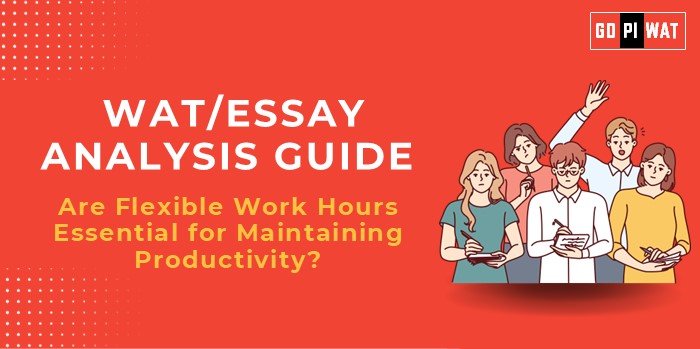📋 Written Ability Test (WAT) Analysis Guide: Flexible Work Hours
🌐 Understanding Flexible Work Hours’ Importance
Flexible work hours are integral to modern workplace discussions, connecting directly to themes like employee well-being, organizational agility, and productivity economics.
📝 Effective Planning and Writing
- ⏳ Time Allocation:
- Planning: 5 minutes
- Writing: 20 minutes
- Review: 5 minutes
- ✍️ Word Count Distribution:
- Introduction: 60 words
- Body: 350 words
- Conclusion: 60 words
💡 Introduction Techniques for Essays
- Contrast:
“While traditional 9-to-5 schedules ensured structure, flexible hours reflect the demands of a connected and diverse workforce.”
- Solution-Oriented:
“Flexible work hours address burnout and productivity challenges, heralding a new era in workplace efficiency.”
- Timeline:
“From an employee perk to a productivity strategy, flexible work hours have reshaped modern industries post-pandemic.”
📊 Structuring the Essay Body
🏆 Achievements
- Highlight increased productivity and employee satisfaction with data.
⚠️ Challenges with Comparative Analysis
- Address team dynamics issues, referencing rigid cultures like Japan’s.
🌍 Future Outlook
- Emphasize policies enabling inclusivity and addressing industry-specific needs.
✍️ Concluding Effectively
- Balanced Perspective:
“Flexible work hours, though transformative, must balance operational goals with workforce diversity and inclusivity.”
- Global Comparison:
“Flexible hours signal progress akin to Estonia’s digital-first workplace policies, yet universal adoption demands tailored solutions.”
📈 Analyzing Successes and Shortcomings
- Key Achievements: Employee well-being, global competitiveness.
- Ongoing Challenges: Work-life boundaries, role-specific feasibility.
- Global Context: Learnings from global pioneers like Microsoft and Estonia.
🌟 Recommendations for Sustainable Progress
- Invest in robust collaboration tools.
- Train leaders to manage diverse teams.
- Tailor flexibility by industry and job role.
📘 Sample Short Essays
- Balanced Perspective:
“Flexible work hours symbolize a shift towards employee-centric workplaces, but their success depends on addressing collaboration barriers and fairness.”
- Solution-Oriented:
“By integrating technology and leadership training, companies can harness the full potential of flexible work hours.”
- Global Comparison:
“Inspired by Estonia’s progressive policies, flexible work hours can transform productivity worldwide, provided challenges are addressed.”


